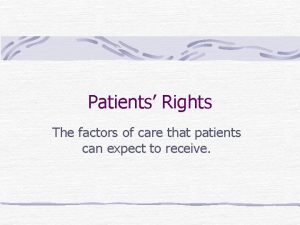Drinking among adult primary care patients Lowrisk drinking


- Slides: 2

Drinking among adult primary care patients Low-risk drinking limits Drinks per week Drinks per day Men 14 4 Women 7 3 All ages >65 7 3 Pregnancy 0 0 5 oz. glass of wine 12 oz. beer IV Severe: 5% Harmful: 8% III II Risky: 9% I Low risk or abstain: 78% 1. 5 oz (shot) of liquor Some risks of unhealthy drinking Depression. Anxiety. Aggressive behavior. Alcohol use disorder. Insomnia. Memory loss. Cancer of the throat and mouth. Premature aging. Hypertension. Heart failure. Anemia. Blood clotting. Breast cancer. Frequent colds, reduced resistance to infection, Increased risk of pneumonia. Vitamin deficiency. Bleeding. Stomach inflammation. Diarrhea. Malnutrition. Liver damage. Pregnancy: Birth defects, miscarriage, premature birth, low birth weight. Inflammation of the pancreas. Impaired sensation leading to falls. Sexually transmitted diseases. Men: erectile dysfunction. Failure to fulfill obligations at work, school, or home. Car accidents. Legal problems. Painful nerves. Numb, tingling toes. Not at all 0 1 Readiness ruler 2 3 4 5 6 7 8 9 10 Very

Steps of the brief intervention Raise the subject • “Thanks for filling out this form – is it okay if we briefly talk about your substance use? ” • “Just so you know, my role is to help you assess the risks so you can make your own decisions. I want to help you improve your quality of life on your own timeline. ” • “What can you tell me about your substance use? ” Share information • Explain any association between the patient’s use and their health complaint, then ask, “Do you think your use has anything to do with your [anxiety, insomnia, STD, etc, ]? ” • Share information about general risks of use and/or low-risk limits of alcohol use. • Ask the patient: “What do you think of this information? ” Enhance motivation • Ask pt about perceived pros and cons of their use, then summarize what you heard. • “Where do you want to go from here in terms of your use? What’s your goal, or vision? ” • Gauge patient’s readiness/confidence to reach their goal. If using Readiness Ruler: “Why do did you pick that number on a scale of 0 -10 instead of ____ [lower number]? ” Identify plan • If patient is ready, ask: “What steps do you think you can take to reach your goal? ” • Affirm the patient’s readiness/confidence to meet their goal and affirm their plan. • “Can we schedule an appointment to check in and see how your plan is going? ” Oregon hotline that quickly identifies resources for patients ready to accept treatment: 1 -800 -923 -4357 Interpreting the AUDIT and DAST screening tools Score Zone Action Billing codes Screening only AUDIT: 0 -3/4 Women/Men USAUDIT: 0 -6/7 Women/Men DAST: 1 -2 (infrequent use of cannabis only) AUDIT: 4 -12, 5 -14 Women/Men USAUDIT: 7/8 -15 Women/Men DAST: 1 -2 AUDIT: 13/15 -19 Women/Men USAUDIT: 16 -19 DAST: 3 -5 AUDIT: 20+ USAUDIT: 20+ DAST: 6+ I Low Risk Brief education Medicaid: CPT 96160 Screening plus brief intervention II Risky III Harmful IV Severe Brief intervention Medicaid: Brief intervention (offer options that include treatment) ≥ 15 min: CPT 99408 ≥ 30 min: CPT 99409 5 -14 min: G 2011 Medicare: ≥ 15 min: G 0396 ≥ 30 min: G 0396 sbirtoregon. org



